 Astronomer Dr. Frank Drake, one of the founders of SETI (the Search for Extra-Terrestrial Intelligences), dies at the age of 92. His fascinating with searching for life on other worlds began at a young age, and defined much of his life and career. In the 1960s, as part of a lecture, he devised the Drake Equation, a formula for calculating a very rough estimate of the possible number of civilizations capable of communicating across interstellar distances; this equation has been debated and challenged over the years, as well as gaining mainstream recognition after being cited in popular science programming (such as Carl Sagan’s Cosmos) and science fiction as well. In the 1970s, Drake and Sagan joined forces to create the “messages in bottles” affixed to the earliest space probes expected to break free of the solar system, including the Pioneer plaques and the golden records attached to Voyagers 1 and 2.
Astronomer Dr. Frank Drake, one of the founders of SETI (the Search for Extra-Terrestrial Intelligences), dies at the age of 92. His fascinating with searching for life on other worlds began at a young age, and defined much of his life and career. In the 1960s, as part of a lecture, he devised the Drake Equation, a formula for calculating a very rough estimate of the possible number of civilizations capable of communicating across interstellar distances; this equation has been debated and challenged over the years, as well as gaining mainstream recognition after being cited in popular science programming (such as Carl Sagan’s Cosmos) and science fiction as well. In the 1970s, Drake and Sagan joined forces to create the “messages in bottles” affixed to the earliest space probes expected to break free of the solar system, including the Pioneer plaques and the golden records attached to Voyagers 1 and 2.
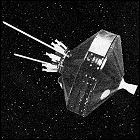 Also referred to as “Pioneer 0”, the Pioneer space probe is launched by the US Air Force, with the intention of sending it to the moon. Just over a minute after Pioneer’s Thor-Able booster lifts off, the first stage explodes, and Pioneer’s short flight ends in the Atlantic Ocean. The next Pioneer space probe will be handled by the newly formed National Aeronautics and Space Administration later in 1958.
Also referred to as “Pioneer 0”, the Pioneer space probe is launched by the US Air Force, with the intention of sending it to the moon. Just over a minute after Pioneer’s Thor-Able booster lifts off, the first stage explodes, and Pioneer’s short flight ends in the Atlantic Ocean. The next Pioneer space probe will be handled by the newly formed National Aeronautics and Space Administration later in 1958.
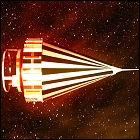 NASA launches the Pioneer 3 space probe, intended – like its predecessors – to visit the vicinity of the moon. Designed to activate a television camera to get the first look at the moon’s far side, Pioneer 3 never reaches its target, only covering a third of the distance between Earth and the moon before it loops back toward Earth and burns up in the atmosphere a day later. Its near-identical twin, Pioneer 4, will be launched in 1959.
NASA launches the Pioneer 3 space probe, intended – like its predecessors – to visit the vicinity of the moon. Designed to activate a television camera to get the first look at the moon’s far side, Pioneer 3 never reaches its target, only covering a third of the distance between Earth and the moon before it loops back toward Earth and burns up in the atmosphere a day later. Its near-identical twin, Pioneer 4, will be launched in 1959.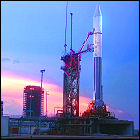 NASA launches Pioneer 10, the first spacecraft sent to study the huge planet Jupiter at close range. Its Atlas-Centaur booster gives it a good head start, propelling it to over 32,000 miles per hour en route to Jupiter, the fastest man-made object in history at this point. Pioneer 10 is also the first man-made vehicle to traverse the asteroid belt, with instruments detecting fewer large particles than anticipated. It will reach Jupiter in late
NASA launches Pioneer 10, the first spacecraft sent to study the huge planet Jupiter at close range. Its Atlas-Centaur booster gives it a good head start, propelling it to over 32,000 miles per hour en route to Jupiter, the fastest man-made object in history at this point. Pioneer 10 is also the first man-made vehicle to traverse the asteroid belt, with instruments detecting fewer large particles than anticipated. It will reach Jupiter in late 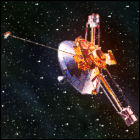 En route to becoming the first human-made spacecraft to visit Jupiter, NASA’s Pioneer 10 also becomes the first human-made spacecraft to enter the asteroid belt between the orbits of Mars and Jupiter. Whether or not the spacecraft will survive this crossing is indeed one of the mission’s major experiments, and is a topic of active debate between scientists with differing views of how densely populated the asteroid belt may be. The spacecraft will survive the crossing without incident.
En route to becoming the first human-made spacecraft to visit Jupiter, NASA’s Pioneer 10 also becomes the first human-made spacecraft to enter the asteroid belt between the orbits of Mars and Jupiter. Whether or not the spacecraft will survive this crossing is indeed one of the mission’s major experiments, and is a topic of active debate between scientists with differing views of how densely populated the asteroid belt may be. The spacecraft will survive the crossing without incident.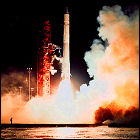 The unmanned space probe Pioneer 11 is launched on a course that will be one of the first real tests of the
The unmanned space probe Pioneer 11 is launched on a course that will be one of the first real tests of the 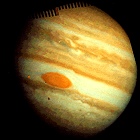 NASA’s Pioneer 10 space probe, launched in
NASA’s Pioneer 10 space probe, launched in 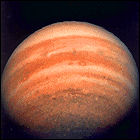 NASA’s Pioneer 11 space probe passes close to Jupiter, barely 27,000 miles above the giant planet’s cloudtops, again encountering radiation capable of frying spacecraft electronics. Pioneer 11 captures the first images of Jupiter’s polar cloud structure and pulls off a daring gravity assist maneuver: the planet’s gravity flings Pioneer 11 up and over the north polar region and across the solar system for a
NASA’s Pioneer 11 space probe passes close to Jupiter, barely 27,000 miles above the giant planet’s cloudtops, again encountering radiation capable of frying spacecraft electronics. Pioneer 11 captures the first images of Jupiter’s polar cloud structure and pulls off a daring gravity assist maneuver: the planet’s gravity flings Pioneer 11 up and over the north polar region and across the solar system for a 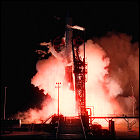 NASA launches the 1,100 pound Pioneer Venus Orbiter, designed to orbit Venus for a year to study the planet’s atmosphere and its interaction with other space phenomena. Though launched separately, the two Pioneer Venus spacecraft will arrive at Venus within days of one another in December 1978. The Orbiter takes radar observations of the cloud-shrouded planet, from which the first surface map of Venus is derived. As with many other unmanned NASA spacecraft designed for relatively short-duration missions, the Pioneer Venus Orbiter outlives its design lifespan, staying fully functional into the 1990s and eventually becoming the only American spacecraft to view Halley’s Comet in 1986.
NASA launches the 1,100 pound Pioneer Venus Orbiter, designed to orbit Venus for a year to study the planet’s atmosphere and its interaction with other space phenomena. Though launched separately, the two Pioneer Venus spacecraft will arrive at Venus within days of one another in December 1978. The Orbiter takes radar observations of the cloud-shrouded planet, from which the first surface map of Venus is derived. As with many other unmanned NASA spacecraft designed for relatively short-duration missions, the Pioneer Venus Orbiter outlives its design lifespan, staying fully functional into the 1990s and eventually becoming the only American spacecraft to view Halley’s Comet in 1986.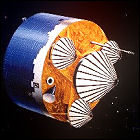 Trailing its supporting orbiter by several months, the Pioneer Venus Multiprobe – also known as Pioneer 13 – lifts off en route to deposit its payload of four atmospheric entry probes designed to measure the planet’s inhospitable, poisonous atmosphere. Following the launch of those probes, the Multiprobe carrier vehicle will then enter the atmosphere of Venus itself and take measurements, burning up before it ever reaches the surface.
Trailing its supporting orbiter by several months, the Pioneer Venus Multiprobe – also known as Pioneer 13 – lifts off en route to deposit its payload of four atmospheric entry probes designed to measure the planet’s inhospitable, poisonous atmosphere. Following the launch of those probes, the Multiprobe carrier vehicle will then enter the atmosphere of Venus itself and take measurements, burning up before it ever reaches the surface.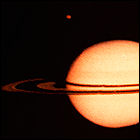 The unmanned space probe Pioneer 11 makes its closest approach to the planet Saturn, the first man-made object to visit the ringed planet. Scientists pay careful attention to Pioneer’s transmissions as it passes between Saturn’s clouds and its rings, watching for signs of damage (or worse) resulting from collision with the tiny particles that are predicted to exist there; Pioneer 11 slides past Saturn at a distance of only 12,800 miles from the planet’s cloudtops. This is Pioneer 11’s last planetary stop.
The unmanned space probe Pioneer 11 makes its closest approach to the planet Saturn, the first man-made object to visit the ringed planet. Scientists pay careful attention to Pioneer’s transmissions as it passes between Saturn’s clouds and its rings, watching for signs of damage (or worse) resulting from collision with the tiny particles that are predicted to exist there; Pioneer 11 slides past Saturn at a distance of only 12,800 miles from the planet’s cloudtops. This is Pioneer 11’s last planetary stop.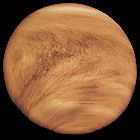 NASA’s unmanned Pioneer Venus Orbiter completes its radar mapping survey of the planet Venus, having used radar to create the first-ever topographical map of that world, which is usually hidden behind a thick, toxic cloud deck. Launched in 1978, Pioneer Venus Orbiter is the only surviving component of the two-vehicle Pioneer Venus mission, but with its solar arrays still gathering adequate power and all of its instruments still functioning well, the orbiter is not deactivated or deorbited at this time; future tasks will be found for it in the years ahead.
NASA’s unmanned Pioneer Venus Orbiter completes its radar mapping survey of the planet Venus, having used radar to create the first-ever topographical map of that world, which is usually hidden behind a thick, toxic cloud deck. Launched in 1978, Pioneer Venus Orbiter is the only surviving component of the two-vehicle Pioneer Venus mission, but with its solar arrays still gathering adequate power and all of its instruments still functioning well, the orbiter is not deactivated or deorbited at this time; future tasks will be found for it in the years ahead.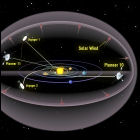 NASA’s Pioneer 10 unmanned spacecraft becomes the first human-made spacecraft to pass beyond the orbit of Pluto, the outermost known planet in the solar system. (Pioneer 10 merely crosses the planet’s orbital path; Pluto itself is in a different part of its orbit, nowhere near Pioneer at the time.) Launched in 1972, Pioneer 10 was the first spacecraft to cross the asteroid belt and observe the giant planet Jupiter at close range, blazing a trial for other outer solar system robotic exploration missions.
NASA’s Pioneer 10 unmanned spacecraft becomes the first human-made spacecraft to pass beyond the orbit of Pluto, the outermost known planet in the solar system. (Pioneer 10 merely crosses the planet’s orbital path; Pluto itself is in a different part of its orbit, nowhere near Pioneer at the time.) Launched in 1972, Pioneer 10 was the first spacecraft to cross the asteroid belt and observe the giant planet Jupiter at close range, blazing a trial for other outer solar system robotic exploration missions.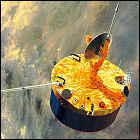 Having received new orders from NASA, the still-functional Pioneer Venus Orbiter – launched in 1978 and in a high, looping orbit over Venus since it ceased active observations of the planet in 1981 – turns its instruments in the direction of Comet Encke, which is currently passing through the inner solar system. Rather than its cameras, the orbiter’s ultraviolet spectrometer is trained on the comet as Earth-based researchers try to determine the composition and rotational speed of Encke’s nucleus. The Pioneer Venus Orbiter will continue to observe other comets through the late 1980s.
Having received new orders from NASA, the still-functional Pioneer Venus Orbiter – launched in 1978 and in a high, looping orbit over Venus since it ceased active observations of the planet in 1981 – turns its instruments in the direction of Comet Encke, which is currently passing through the inner solar system. Rather than its cameras, the orbiter’s ultraviolet spectrometer is trained on the comet as Earth-based researchers try to determine the composition and rotational speed of Encke’s nucleus. The Pioneer Venus Orbiter will continue to observe other comets through the late 1980s.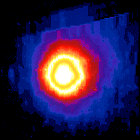 Having already conducted measuresment of Comets Encke and Giacobini-Zinner, the still-functioning Pioneer Venus Orbiter, launched in 1978, becomes the centerpiece of the American effort to gather close-up data on Halley’s Comet. Imaging the comet in ultraviolet light, Pioneer Venus captures Halley from a unique vantage point: both the comet and the planet being orbited by Pioneer are on the opposite side of the sun from Earth, when Halley is at its closest approach to the sun – an event that no other spacecraft is in a position to witness. The Pioneer Venus data will become the most critical data gathered on Halley by an American spacecraft after a planned March 1986 Space Shuttle mission to image the comet from Earth orbit is scrapped in the wake of the Challenger disaster in January.
Having already conducted measuresment of Comets Encke and Giacobini-Zinner, the still-functioning Pioneer Venus Orbiter, launched in 1978, becomes the centerpiece of the American effort to gather close-up data on Halley’s Comet. Imaging the comet in ultraviolet light, Pioneer Venus captures Halley from a unique vantage point: both the comet and the planet being orbited by Pioneer are on the opposite side of the sun from Earth, when Halley is at its closest approach to the sun – an event that no other spacecraft is in a position to witness. The Pioneer Venus data will become the most critical data gathered on Halley by an American spacecraft after a planned March 1986 Space Shuttle mission to image the comet from Earth orbit is scrapped in the wake of the Challenger disaster in January.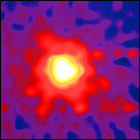 A victory lap after its successful study of Halley’s Comet in 1985 and 1986, the Pioneer Venus Orbiter uses its unique position at the solar system’s second planet to observe another comet, the recently-discovered Comet Wilson. Spotted for the first time only the year before, little is known about Comet Wilson, a lack of data that Pioneer Venus helps to correct by imaging the comet in the ultraviolet portion of the spectrum. Pioneer Venus will also study two other comets later in 1987.
A victory lap after its successful study of Halley’s Comet in 1985 and 1986, the Pioneer Venus Orbiter uses its unique position at the solar system’s second planet to observe another comet, the recently-discovered Comet Wilson. Spotted for the first time only the year before, little is known about Comet Wilson, a lack of data that Pioneer Venus helps to correct by imaging the comet in the ultraviolet portion of the spectrum. Pioneer Venus will also study two other comets later in 1987.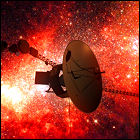 Unmanned space prove Voyager 1, launched in 1977, surpasses its forerunner Pioneer 10 as the furthest man-made object in space. Due to a sharp increase in its speed imparted by a very close pass by Saturn’s large moon Titan in 1980, Voyager 1 has outrun Pioneer 10, which was launched in 1972. Both vehicles are still returning science data, and Voyager 1 is now 6.5 billion miles from the sun, 70 times further out from the sun than Earth. Voyager’s on-board nuclear power source is expected to keep it active through 2020.
Unmanned space prove Voyager 1, launched in 1977, surpasses its forerunner Pioneer 10 as the furthest man-made object in space. Due to a sharp increase in its speed imparted by a very close pass by Saturn’s large moon Titan in 1980, Voyager 1 has outrun Pioneer 10, which was launched in 1972. Both vehicles are still returning science data, and Voyager 1 is now 6.5 billion miles from the sun, 70 times further out from the sun than Earth. Voyager’s on-board nuclear power source is expected to keep it active through 2020. Astronomer Dr. Frank Drake, one of the founders of SETI (the Search for Extra-Terrestrial Intelligences), dies at the age of 92. His fascinating with searching for life on other worlds began at a young age, and defined much of his life and career. In the 1960s, as part of a lecture, he devised the Drake Equation, a formula for calculating a very rough estimate of the possible number of civilizations capable of communicating across interstellar distances; this equation has been debated and challenged over the years, as well as gaining mainstream recognition after being cited in popular science programming (such as Carl Sagan’s Cosmos) and science fiction as well. In the 1970s, Drake and Sagan joined forces to create the “messages in bottles” affixed to the earliest space probes expected to break free of the solar system, including the Pioneer plaques and the golden records attached to Voyagers 1 and 2.
Astronomer Dr. Frank Drake, one of the founders of SETI (the Search for Extra-Terrestrial Intelligences), dies at the age of 92. His fascinating with searching for life on other worlds began at a young age, and defined much of his life and career. In the 1960s, as part of a lecture, he devised the Drake Equation, a formula for calculating a very rough estimate of the possible number of civilizations capable of communicating across interstellar distances; this equation has been debated and challenged over the years, as well as gaining mainstream recognition after being cited in popular science programming (such as Carl Sagan’s Cosmos) and science fiction as well. In the 1970s, Drake and Sagan joined forces to create the “messages in bottles” affixed to the earliest space probes expected to break free of the solar system, including the Pioneer plaques and the golden records attached to Voyagers 1 and 2.